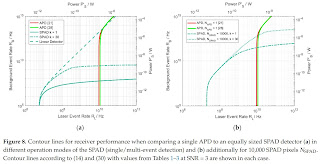"Designers of optical systems for ranging applications can choose from a variety of highly sensitive photodetectors, of which the two most prominent ones are linear mode avalanche photodiodes (LM-APDs or APDs) and Geiger-mode APDs or single-photon avalanche diodes (SPADs). Both achieve high responsivity and fast optical response, while maintaining low noise characteristics, which is crucial in low-light applications such as fluorescence lifetime measurements or high intensity measurements, for example, Light Detection and Ranging (LiDAR), in outdoor scenarios. The signal-to-noise ratio (SNR) of detectors is used as an analytical, scenario-dependent tool to simplify detector choice for optical system designers depending on technologically achievable photodiode parameters. In this article, analytical methods are used to obtain a universal SNR comparison of APDs and SPADs for the first time. Different signal and ambient light power levels are evaluated. The low noise characteristic of a typical SPAD leads to high SNR in scenarios with overall low signal power, but high background illumination can saturate the detector. LM-APDs achieve higher SNR in systems with higher signal and noise power but compromise signals with low power because of the noise characteristic of the diode and its readout electronics. Besides pure differentiation of signal levels without time information, ranging performance in LiDAR with time-dependent signals is discussed for a reference distance of 100 m. This evaluation should support LiDAR system designers in choosing a matching photodiode and allows for further discussion regarding future technological development and multi pixel detector designs in a common framework."
SPAD vs APD in ToF Applications
MDPI publishes a paper "Analytical Evaluation of Signal-to-Noise Ratios for Avalanche- and Single-Photon Avalanche Diodes" by Andre Buchner, Stefan Hadrath, Roman Burkard, Florian M. Kolb, Jennifer Ruskowski, Manuel Ligges, and Anton Grabmaier from Fraunhofer Institute for Microelectronic Circuits and Systems, OSRAM, and University of Duisburg-Essen, Germany.





0 Response to "SPAD vs APD in ToF Applications"
Post a Comment